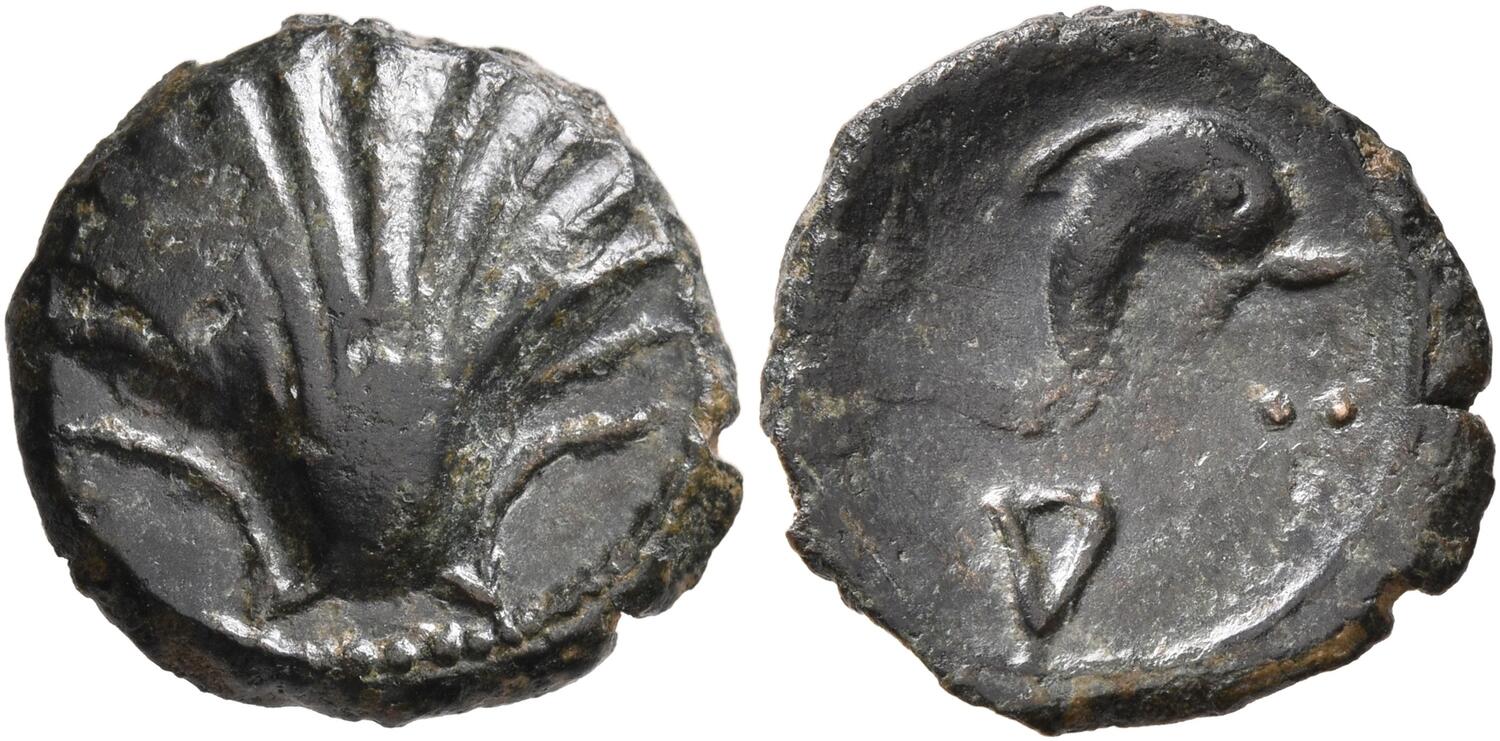S 1674 - Arse-Saguntum, bronze, quadrantes (195-130 BCE)
From SILVER
195 BCE - 130 BCE Bronze
Description
| ObverseInscription or printing placed on the obverse.: | Scallop shell |
| ReverseInscription or printing placed on the reverse.: | (Iberic).Dolphin right, above, crescent, below, Iberian letter 'a' and three pellets |
Mint and issuing power
| MintIdentifies the place of manufacture or issue of a numismatic object.: | Arse-Saguntum | Ancient regionAncient region.: | Hispania Citerior | Modern countryModern country: Spain | AuthorityIdentifies the issuing power. The authority can be "pretended" when the name or the portrait of X is on the coin but he/she was not the issuing power. It can also be "uncertain" when there is no mention of X on the coin but he/she was the issuing power according to the historical sources: | Roman Republic |
Chronology
| FromIdentifies the initial date in a range assigned in a numismatic context. | 195 BCE | toIdentifies the final date in a range assigned in a numismatic context.. | 130 BCE | PeriodTime period of the numismatic object.: Hellenistic 323-30 BC |
Physical description
| MetalThe physical material (usually metal) from which an object is made.: | Bronze |
Median weightMedian of the weights of numismatic objects (in grams). in grams | 2.90 | DenominationTerm indicating the value of a numismatic object. Examples: tetradrachm, chalkous, denarius.: | quarter | StandardStandard.: |
Image

S 1674 - Arse, bronze, quarters (195-130 BCE).jpg [1]
References
| Die study referencePublication of the study: | Ripollès - Llorens 20021Ripollès - Llorens 2002, p. 400-413: O81-112/ R104-137 (Period II) | ||
| Coin series referenceReference to coin series study: | |||
Obverse dies distribution
| FrequencyFrequency of specimen in distribution. ᵖ | Number of obversesNumber of obverse dies. ᵖ (o) | % (o) | Number of coinsNumber of coins. (n) | % (n) | Die nameName(s) of the die(s). |
| 1 | 2 | 6.06 | 2 | 0.71 | 100, 110 |
| 2 | 6 | 18.18 | 12 | 4.26 | 91, 94, 95, 96, 98, 105 |
| 3 | 2 | 6.06 | 6 | 2.13 | 87, 90 |
| 4 | 4 | 12.12 | 16 | 5.67 | 82, 84, 89, 99 |
| 5 | 3 | 9.09 | 15 | 5.32 | 85, 88, 109 |
| 6 | 1 | 3.03 | 6 | 2.13 | 83 |
| 7 | 2 | 6.06 | 14 | 4.96 | 81, 113 |
| 10 | 1 | 3.03 | 10 | 3.55 | 86 |
| 11 | 1 | 3.03 | 11 | 3.9 | 111 |
| 12 | 1 | 3.03 | 12 | 4.26 | 93 |
| 14 | 3 | 9.09 | 42 | 14.89 | 102, 107, 108 |
| 16 | 2 | 6.06 | 32 | 11.35 | 101, 104 |
| 19 | 3 | 9.09 | 57 | 20.21 | 97, 103, 112 |
| 22 | 1 | 3.03 | 22 | 7.8 | 106 |
| 25 | 1 | 3.03 | 25 | 8.87 | 92 |
| Total | 33 of 33 | 99.99 | 282 of 282 | 100.01 |
Reverse dies distribution
no distribution is available
Quantification
| Number of obversesNumber of obverse dies. ᵖ (o) | 33 | Number of singletons (o1)The number of singleton coins. ᵖ | 2 |
| Number of reverse diesNumber of reverse dies. (r) | 35 | Number of coinsNumber of coins. (n) | 282 |
| Coins per obverse dieNumber of coins per obverse die. (n/o) | 8.55 | Coins per reverse dieNumber of coins per reverse die. (n/r) | 8.06 |
| Reverse per obverse ratioRatio of obverse dies divided by reverse dies. (r/o) | 1.06 | Percentage of singletons (o1)number of coins (n) divided by the number of singletons (o1) ᵖ | 6.06 % |
| Original number of dies (O) (Carter 1983 formula)The estimation of the number of coins according to Carter 1983 ᵖ | 34.01 | Coins struck if 20,000 as average productivity per dieCoins made if the average productivity for obverses (according to Carter) is 20,000. ᵖ | 680,200 |
| Original number of dies (O) (Esty 2011 formula)The estimation of the number of coins according to the singleton formula in Esty 2011 ᵖ (O) | 37.37 | Survival rate if 20,000 as average productivity per dieSurvival rate if average productivity is 20,000. ᵖ | 0.00041 |
| Coverage (o = % of O) (Esty 1984 formula)Esty 1984 - coverage (% of O) ᵖ (o = % of O) | 99.29% | Die productivity if survival rate 1/2,000Average productivity if survival rate is 1/2,000. ᵖ | 16,583.36 |
| Weight of silver (in kg) if 20,000 coins per die (O = Carter formula)Carter 1983 * Median weight * 20000 (*10 if gold or electrum) ᵖ | n.a. | Die productivity if survival rate 1/5,000Average productivity if survival rate is 1/5,000. ᵖ | 41,458.39 |
Remarks
Most likely two workstations See chart p. 191-192